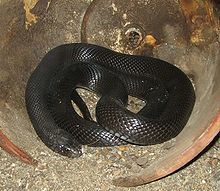Walterinnesia aegyptia, also known as the desert cobra or desert black snake, is a species of venomous snakes in the family Elapidae that is native to the Middle East. The specific epithet aegyptia (“of Egypt”) refers to part of its geographic range.[2]
| Walterinnesia aegyptia | |
|---|---|

| |
| Walterinnesia aegyptia | |
| Scientific classification | |
| Domain: | Eukaryota |
| Kingdom: | Animalia |
| Phylum: | Chordata |
| Class: | Reptilia |
| Order: | Squamata |
| Suborder: | Serpentes |
| Family: | Elapidae |
| Genus: | Walterinnesia |
| Species: | W. aegyptia
|
| Binomial name | |
| Walterinnesia aegyptia Lataste, 1887
| |
Description and behaviour
edit(See the article on the genus at Walterinnesia)
Distribution
editThe range of the species encompasses southern Israel, north-western Saudi Arabia, western Jordan, Iraq, Egypt’s Sinai Peninsula and possibly Lebanon. The type locality is Cairo, where the type specimen was purchased.[2]
Venom
editThe desert cobra is highly venomous. The subcutaneous LD50 for the venom of W. aegyptia is 0.4 mg/kg. For comparison, the Indian cobra's (Naja naja) subcutaneous LD50 is 0.80 mg/kg, while the Cape cobra's (Naja nivea) subcutaneous LD50 is 0.72 mg/kg. This makes the desert black snake a more venomous snake than both.[3] Venom toxins of the desert cobra are similar to those of the king cobra (Ophiophagus hannah), indicating a close relationship.[2]
Like many elapid snakes, the venom is primarily neurotoxic and the effects of envenenomation are due to systemic circulation of the toxins rather than from local effects on tissue near the site of injection.[4]
References
edit- ^ Amr, Z.S.S.; Al Johany, A.M.H.; Egan, D.M.; Baha El Din, S.; Ugurtas, I.H.; Werner, Y.L.; Disi, A.M.; Tok, V.; Sevinç, M. (2017) [errata version of 2012 assessment]. "Walterinnesia aegyptia". IUCN Red List of Threatened Species. 2012: e.T164671A115304177. doi:10.2305/IUCN.UK.2012.RLTS.T164671A1066007.en. Retrieved 21 February 2022.
- ^ a b c "Walterinnesia aegyptia LATASTE, 1887". Reptile Database. Peter Uetz and Jakob Hallermann. Retrieved 2 June 2021.
- ^ "LD50 Menu". Archived from the original on 2012-02-01. Retrieved 2011-10-11.
- ^ Longo DL, Fauci AS, Kasper DL, Hauser SL, Jameson J, Loscalzo J (editors) (2012). Harrison's Principles of Internal Medicine, 18th Edition. New York: McGraw-Hill. 4,012 pp. ISBN 978-0071748896.
